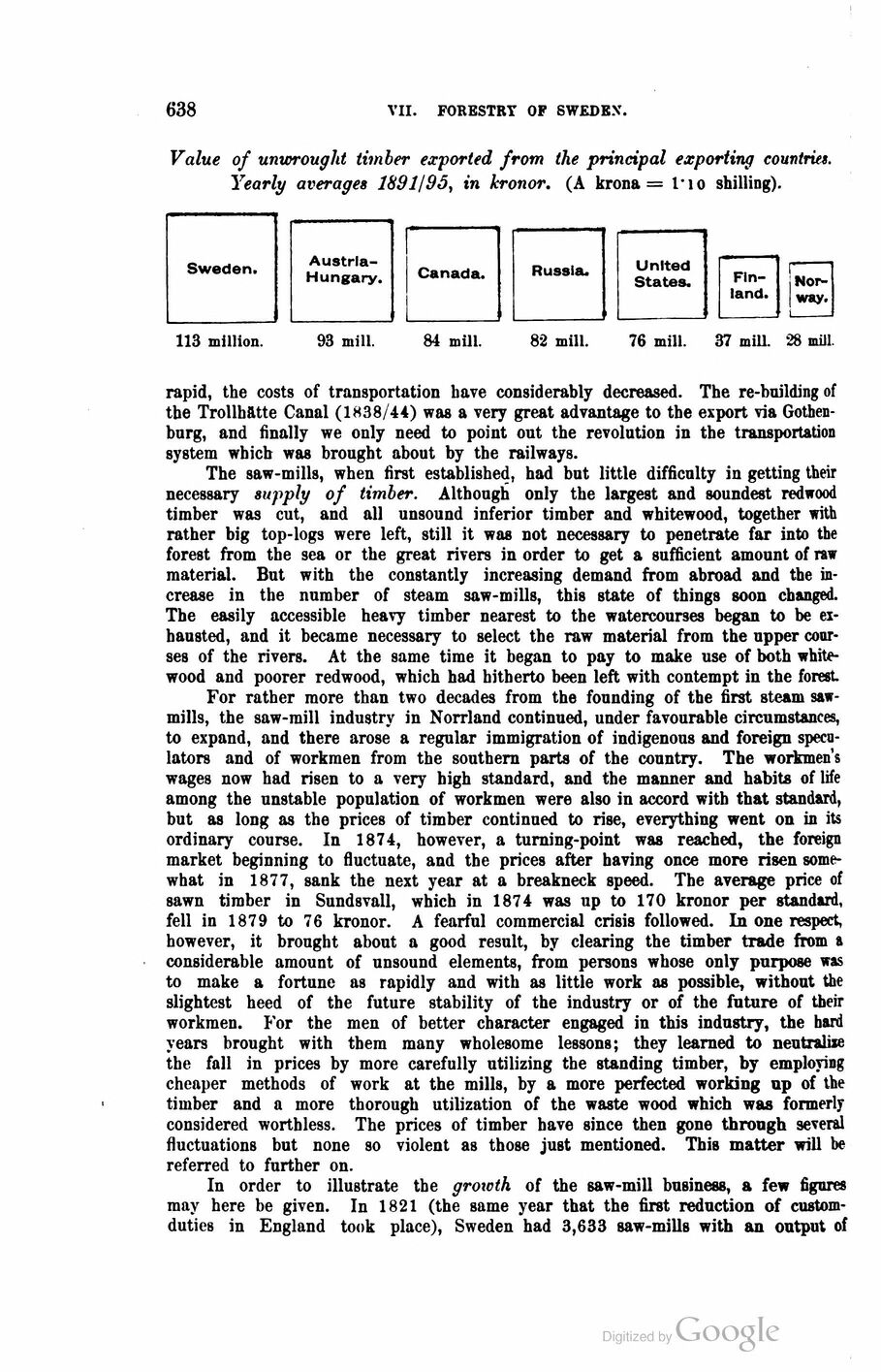
Full resolution (JPEG) - On this page / på denna sida - Second part - VII. Forestry - 2. Forest Industries. By E. Arosenius, Ph. D., Royal Central Bureau of Statistics, Stockholm

<< prev. page << föreg. sida << >> nästa sida >> next page >>
Below is the raw OCR text
from the above scanned image.
Do you see an error? Proofread the page now!
Här nedan syns maskintolkade texten från faksimilbilden ovan.
Ser du något fel? Korrekturläs sidan nu!
This page has never been proofread. / Denna sida har aldrig korrekturlästs.
638
VII. FORESTRY OF SWEDEN’.
Value of unwrought timber exported from the principal exporting countries.
Yearly averages 1891/95, in kronor. (A krona = lmo shilling).
rapid, the costs of transportation have considerably decreased. The re-building of
the Trollhätte Canal (1838/44) was a very great advantage to the export via
Gothenburg, and finally we only need to point out the revolution in the transportation
system which was brought about by the railways.
The saw-mills, when first established, had but little difficulty in getting their
necessary supply of timber. Although only the largest and soundest redwood
timber was cut, and all unsound inferior timber and whitewood, together with
rather big top-logs were left, still it was not necessary to penetrate far into the
forest from the sea or the great rivers in order to get a sufficient amount of raw
material. But with the constantly increasing demand from abroad and the
increase in the number of steam saw-mills, this state of things soon changed.
The easily accessible heavy timber nearest to the watercourses began to be
exhausted, and it became necessary to select the raw material from the upper
courses of the rivers. At the same time it began to pay to make use of both
white-wood and poorer redwood, which had hitherto been left with contempt in the forest.
For rather more than two decades from the founding of the first steam
sawmills, the saw-mill industry in Norrland continued, under favourable circumstances,
to expand, and there arose a regular immigration of indigenous and foreign
speculators and of workmen from the southern parts of the country. The workmen’s
wages now had risen to a very high standard, and the manner and habits of life
among the unstable population of workmen were also in accord with that standard,
but as long as the prices of timber continued to rise, everything went on in its
ordinary course. In 1874, however, a turning-point was reached, the foreign
market beginning to fluctuate, and the prices after having once more risen
somewhat in 1877, sank the next year at a breakneck speed. The average price of
sawn timber in Sundsvall, which in 1874 was up to 170 kronor per standard,
fell in 1879 to 76 kronor. A fearful commercial crisis followed. In one respect,
however, it brought about a good result, by clearing the timber trade from a
considerable amount of unsound elements, from persons whose only pnrpose was
to make a fortune as rapidly and with as little work as possible, without the
slightest heed of the future stability of the industry or of the future of their
workmen. For the men of better character engaged in this industry, the band
years brought with them many wholesome lessons; they learned to neutr&liie
the fall in prices by more carefully utilizing the standing timber, by employing
cheaper methods of work at the mills, by a more perfected working up of the
timber and a more thorough utilization of the waste wood which was formerly
considered worthless. The prices of timber have since then gone through several
fluctuations but none so violent as those just mentioned. This matter will be
referred to further on.
In order to illustrate the groicth of the saw-mill business, a few figures
may here be given. In 1821 (the same year that the first reduction of
custom-duties in England took place), Sweden had 3,633 saw-mills with an output of
<< prev. page << föreg. sida << >> nästa sida >> next page >>